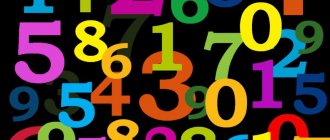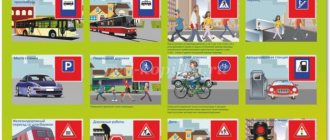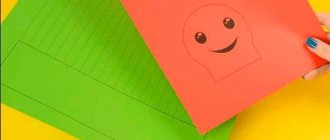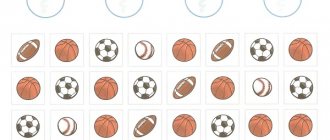Children become familiar with greater and less than signs in mathematics even before entering first grade. Children often get confused about what a specific symbol means. Parents can help their children in this matter, which will have a positive impact on their children’s academic performance. This knowledge will be useful to kids in the future - when studying geometry, in algebra lessons, in examples where square and other powers of numbers are used. The tips in this article will help parents teach their kids important mathematical wisdom.
Greater than or equal to / less than or equal to signs
The signs “greater than or equal to” and “less than or equal to” look like “≥”, “≤” respectively. They are the result of combining two characters - ">" or "<" and one line.
This line is below the arrow. In this case, the arrow does not intersect with the line below it. Typically the bottom line follows the principle of being parallel to the bottom of the symbol.
These signs are used in non-strict inequalities. In first grade, such inequalities are usually not studied.
"Arrows"
Primary school children need to explain signs based on the principle of comparing them to arrows that are directed in opposite directions. In this case, it is important to clarify that the arrow always points to the number that is smaller. If the child learns this, then he will not have any difficulties with making signs. He can easily determine how to place the arrow correctly.
Children have difficulties when reading expressions. But they are also easy to eliminate: if the sign is placed correctly, then they will read the expression without problems. After completing a small number of tasks, it will become clear to the child that an arrow pointing to the left means a “less” sign, while an arrow pointing to the right means “more.”
Games for quickly memorizing the signs “greater than” and “less than”
There are various logic games using mathematical symbols. There are many such games. Below are three games where children can play with the ">" and "<" arrows.
Game "Big Hungry Crocodile"
This is the easiest and most visual way to remember once and for all which way the “greater than” and “less than” signs are written. On a sheet of paper you need to draw two round plates. The diameter of each plate must be at least 10 centimeters.
On each of the “plates” you can put something roughly resembling food. For example, you can make balls from plasticine or salt dough and agree with your child that the peas mean crocodile cutlets. For this game it is enough to make one symbol. It can be done on a small card. The notations “>” and “<” roughly resemble the open mouth of a crocodile.
An important condition is that the crocodile always chooses only the plate that has the most food on it!
You need to tell your child about this.
It is necessary to place a certain number of “cutlets” on both “plates”. Then have the child place the card so that the “crocodile’s mouth” faces toward the “plate” that has more “cutlets” on it.
Game "What is more?"
In this game, the combination of the thumb and index finger of the left hand represents the symbol "<", and the combination of the thumb and index finger of the right hand represents the symbol ">". To indicate what is greater, it is enough to extend your right hand, and the left hand is needed to indicate what is less.
In this comparison game you can use not only numbers, but also images of various objects, as well as geometric shapes of different sizes. This activity game can be performed during meals by placing cookies, candies, apples and other foods on the table. This is how you can remember the correct spelling of signs long before school.
Game "Cubes and boards"
This game belongs to the category of active games, since children need to perform actions not only of a mental nature, but also to be active builders. For this game you will need the following supplies: large cubes and two straight boards. One board must be placed on a horizontal surface. Place the cubes in columns on both edges of the lying board.
It is important that the columns be even, like an exclamation point. For example, the first (left) column consists of 4 cubes, and the second of 2. Then you need to put the second board on both posts. Eventually, the combination of the bottom and top boards will reveal the correct symbol. In this example, the notation “>” will be obtained.
With each subsequent time, you can change the number of cubes in the columns. When the columns contain the same number of cubes, the boards will show “equal”.
"Hungry Bird"
You will need a sign - an open beak of a bird (the “more” sign). You can make it from cardboard or take a disposable plate. To arouse the child's interest, you can add beak, eyes and other parts of the body.
Start explaining like this: “This bird loves a hearty lunch. And she will choose the heap that is larger.” Then clearly demonstrate how she opens her beak in the direction where there are more grains.”
To consolidate the information received, place 2 piles of grain on the table and ask the child to determine where the bird will turn its beak. If he doesn’t succeed the first time, repeat to him that the beak needs to be opened to the side where there is more food. Next, offer him several similar tasks, for example, writing numbers on paper.
For variety, the bird can be replaced with another predatory animal (crocodile), which will open its mouth to the side with more. If a situation arises where both piles contain the same amount of food, and the child notices this, this indicates his attentiveness. For this you will need to praise the baby and show him two equal stripes. It should be made clear that they are equal to the number of items in each pile. Therefore, such a sign is called “equal”.
Mathematical signs
Most likely, by the time the child reaches first grade, he or she can already distinguish aurally and visually that a handful of ten berries is more than three. To introduce new designations into life, let’s look at the signs “greater than”, “less than”, “equal” in pictures.
The greater than symbol (>) is when the sharp nose of the checkmark is pointing to the right. It should be used when the first number is greater than the second:
The less-than symbol (<) is when the sharp nose of the checkmark is pointing to the left. It should be used when the first number is less than the second:
The equal symbol (=) is when two short lines are written horizontally and parallel to each other. We use it when comparing two identical numbers:
To make it easier for a child to remember similar signs, you can use the game method. To do this, you need to compare the numbers and determine in what order they are. Next, we put one dot next to the smallest number and two next to the largest. We connect the dots and get the desired sign. It's as simple as that:
Below is a color representation of the mathematical symbols. When teaching, they can be used directly from the monitor screen or they can be printed on a color printer.
Sorting
There remains one concept that is inextricably linked with the concept of comparison, we are talking about sorting .
We will call a series of different numbers sorted in ascending order if each next number in it is greater than the previous one.
Example of a series sorted in ascending order:
1, 4, 6, 32, 99, 100, 127
Let's look at another row:
1, 6, 2, 9, 12
It can no longer be called sorted in ascending order, since the third element is smaller than the second.
But if we swap them, then the series
1, 2, 6, 9, 12
already sorted in ascending order.
The sorting can also be in descending order.
We will call a series of different numbers sorted in descending order if each next number in it is less than the previous one.
For example, such a series can be called sorted in descending order:
436, 387, 124, 76, 9, 2
But this can no longer be said about such a series:
363, 236, 481, 13, 5
This row is not sorted in descending order because the third element is larger than the second.
Sorting is a fairly common concept.
In almost any online store you can see a selection of sorting options. If we are talking about price, then this will be sorted in descending or ascending order.
In computer science and computer science, sorting algorithms are basic and you will learn about them later in related courses.
For now, it’s important to remember the definition yourself.
Take the test Close the test You can take the test and get a grade after logging in or registering Login Registration
Graphic method
This method is suitable for those who have already been trained in one of the above methods and are well oriented. It is not recommended to start studying it with a preschool child.
The bottom line is that you need to draw the signs “>” and “<” of a sufficiently large size on a piece of paper. In the first case, if you look from the left, the distance between the lines is quite large - which means this is the “more” symbol. The second sign has a small distance on the left side, so this is “less”.
Popular
Skills December 15, 2019
Mathematics August 26, 2022 Find a pattern A pattern is a regular, stable relationship in the quantities, properties and phenomena of objects. In a mathematical pattern, you need to find an algorithm according to which in a chain of numbers they are repeated, changed or replaced in accordance with the established rule.
Love of learning September 6, 2022 How to solve puzzles? Solving puzzles is a great pastime for lovers of all kinds of puzzles and riddles. This is an exciting process, the essence of which is to decipher a word, phrase or sentence using pictures and clue symbols: numbers, letters, commas and other symbols.
Types of inequalities
- Strict inequalities - use only the greater than (>) or less than (<) sign.
- a < b - this means that a is less than b.
- a > b - this means that a is greater than b.
- the inequalities a > b and b < a mean the same thing, that is, they are equivalent.
- Loose inequalities - use comparison signs ≥ (greater than or equal) or ≤ (less than or equal).
- a ≤ b - this means that a is less than or equal to b.
- a ≥ b - this means that a is greater than or equal to b.
- the signs ⩽ and ⩾ are opposite.
- Other types of inequalities.
- a ≠ b - means that a is not equal to b.
- a ≫ b - means that a is much larger than b.
- a ≪ b - means that a is much smaller than b.
- the signs >> and << are opposite.
Sources
- https://skysmart.ru/articles/mathematic/znaki-bolshe-menshe-ili-ravno
- https://kakpravilno05.ru/kak-pishetsja-znaki-bolshe-i-menshe-v-matematike/
- https://linchakin.com/%D1%81%D0%BB%D0%BE%D0%B2%D0%B0%D1%80%D1%8C/%D0%B7/%D0%B7%D0%BD %D0%B0%D0%BA%D0%B8_%D0%B1%D0%BE%D0%BB%D1%8C%D1%88%D0%B5_%D0%B8_%D0%BC%D0%B5%D0 %BD%D1%8C%D1%88%D0%B5/
- https://nauka.club/matematika/znak-bolshe-i-menshe.html
- https://Sprint-Olympic.ru/uroki/matematika-uroki/92800-znaki-bolshe-i-menshe-v-matematike-sravnenie-chisel-s-primerami.html
[collapse]
Equality and inequality
What is equality in mathematics is when one thing is similar in quantity to another and you can put an = sign between them.
For example, let's look at a picture depicting geometric shapes. The quantity on the right and left is the same, which means you can put the “equals” symbol.
An inequality is an algebraic expression that uses the signs ≠, <, >, ≤, ≥.
A clear example of inequality is shown in the picture below. We see three figures on the left, and four on the right. At the same time, we know that three is not equal to four, or else: three is less than four.
A lesson at school often takes place in front of a textbook, notebook and blackboard. At home, you can use a computer and complete some tasks online. How to find characters on the keyboard? The answer is in the picture:








